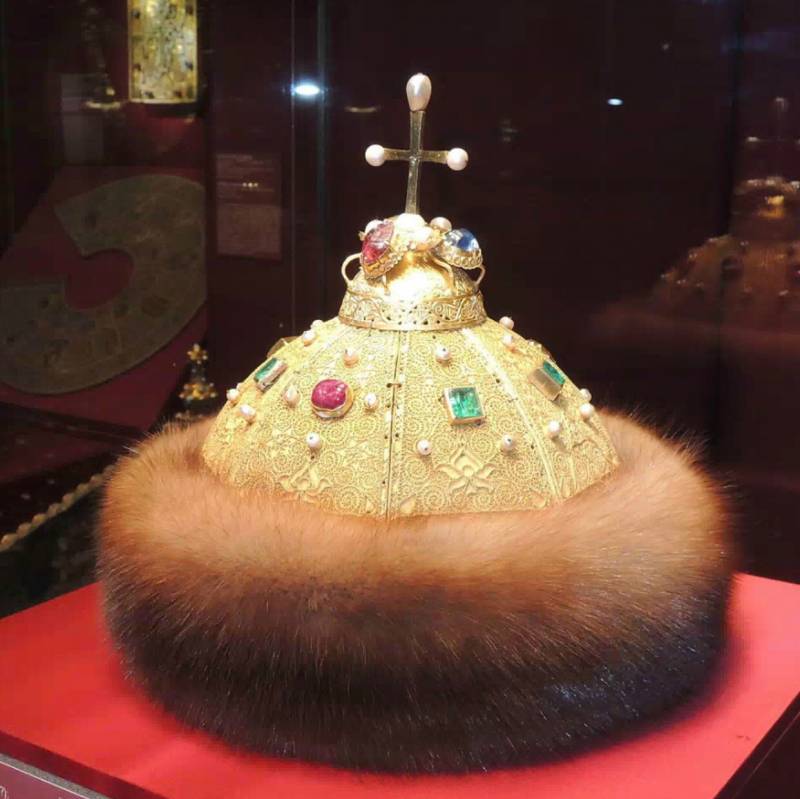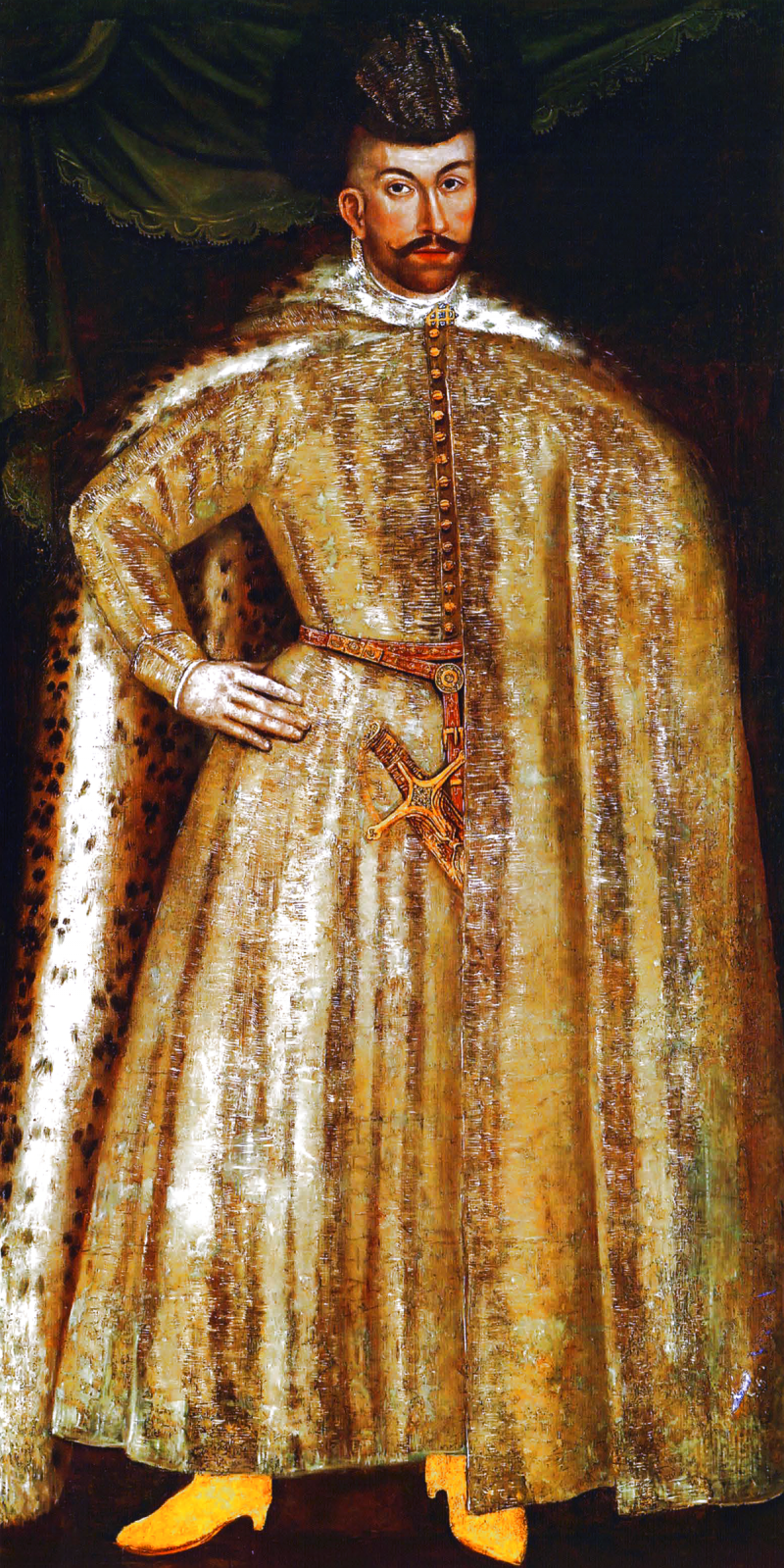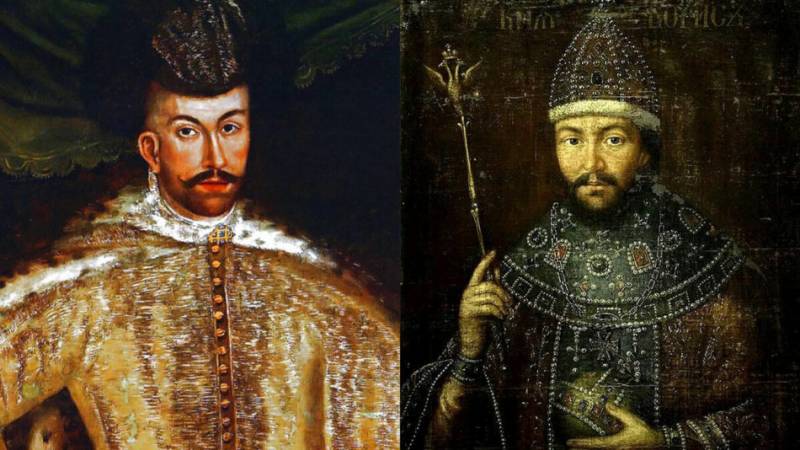The wedding to the kingdom of Ivan the Terrible. On the contribution of the family of Maria Temryukovna to the recognition of the royal title

Cap of Monomakh, in which Ivan the Terrible was married to the kingdom.
In the Assumption Cathedral of the Moscow Kremlin on January 16, 1547, a solemn ceremony of the wedding to the kingdom of Ivan the Terrible took place. Historians unanimously agree that the idea of crowning Ivan to the kingdom belonged to Metropolitan Macarius, but they also mention that this was the desire of Father Vasily III on his deathbed.
The word king is a distorted pronunciation of the Latin word caesar - Caesar or Caesar. It was used by the Slavs to refer to the Roman and Byzantine emperors. This influenced the fact that the Byzantine capital began to be called Constantinople. Khans of the Golden Horde were also called kings.
In diplomatic language, the title "Grand Duke" stood on the same level as the titles "prince" and "duke", which was lower than the titles "king", "king" or "emperor". The adoption of the title of king by Ivan was an increase in the international status of the Moscow state and its prestige. But what is good for the Russian tsar is bad for the Polish king.
V. A. Mazurov writes that “all the eastern Russian lands were part of the Grand Duchy of Moscow by the time Ivan IV ascended the throne, the western ones were part of the Grand Duchy of Lithuania, and Galicia was part of Poland” [1]. In 1514 Moscow regained Smolensk. Short-term wars broke out, the conflict was extinguished by means of a temporary truce. The matter did not reach the signing of a peace treaty. Poland demanded not only Smolensk, but also Novgorod and Pskov, as the old possessions of the Lithuanian principality. Do not put your finger in the mouth of the Poles, not only will they bite off their hands, but they will also try to tear off their heads.
Moscow did not give up either, demanding back all the Russian lands that fell under Polish rule. V. A. Mazurov provides information:
The parties could not agree in any way, the negotiations reached a dead end, the diplomats left with pomp and returned after a while to the negotiating table. And then there was a new dispute over the title. Ivan the Terrible, rising above the title of Grand Duke to equal in size to kings, received an additional argument to demand the return of Russian lands.
No longer the Grand Duke, but the tsar declares himself the successor of the scattered Russian lands, and this status obliged the Poles to return these lands to him. But Poland did not want to do this.

Cherkasov as Ivan IV in S. Eisenstein's film "Ivan the Terrible". An excerpt from the procedure of the wedding to the kingdom.
Here is what R. G. Skrynnikov wrote about the wedding to the kingdom:
V. A. Kobrin echoed the barbs of the Poles:
There is no need to explain that the headdress, which was called Monomakh's hat, is in fact a golden skullcap of Central Asian work, trimmed with sable and topped with a cross already in Moscow ”[4], touching Grandfather the Terrible, notes that “Ivan III used it only in relations with the Livonian Order and some German princes.
The conclusion suggests itself: historians are not lenses at all and are biased towards Grozny.
In this connection, I would like to briefly history appearance of the first Polish king Boleslav.
In 997, Bishop Adalber (Wojciech) of Prague was killed in East Prussia, who went to convert the Prussians to neighboring lands to Christianity. For the remains of the bishop, Boleslav paid in gold a multiple of the weight of the body. The body of the deceased bishop was transported to Poland and buried in the town of Gnezdo. This gesture of redemption of the remains was highly appreciated by the German king and Holy Roman Emperor Otto III. Being greatly impressed by the act of Boleslav, who paid a huge sum for the late bishop, the emperor proposes to call Boleslav not a prince, but a king [5].
Take, for example, England.
If we search the Internet for “Who became the first king of England”, we get the answer: “King of Wessex in 871-899/901. The first of the Anglo-Saxon rulers of Britain began to call himself King of England.
Regarding France, N. Pronina writes:
The historian Kobrin wrote about his Russian rulers as follows: “After all, they were all only Grand Dukes, only sometimes, not so much in official documents as in journalism, they were called tsars for greater solemnity” [7]. This barb concerns Grandfather Grozny to a greater extent. It is emphasized that Grozny's grandfather called himself tsar only with the Livonians and some German princes.
More double standards.
In the West, when they want, the rulers raise their status, and everyone else is forbidden to do so. They could easily appoint kings or proclaim themselves kings, and the Muscovite kingdom, in their opinion, had no right to do this.
As historians write, the first mention of the treatment using the royal title in diplomatic correspondence between the Polish and Russian sides appeared in 1489. The ambassador of the Holy Roman Empire offered Ivan III the royal title, but he refused. According to the current practice, if you accept a title from a ruler of higher rank, then the one who accepts becomes a vassal of the title holder.
The Rosarkhiv preserved a letter of 1514 from Maximilian I [8] to the father of Grozny, Grand Duke Vasily III, in which the prince was called the title “kayser” – caesar, emperor. In 1718, Tsar Peter ordered this charter to be printed in European languages to justify his imperial title.
The inner circle of the king was not happy about the rise of the king. They supported the claims of the Western "partners" in their desire to deprive Grozny of this important title.
I. Ya. Froyanov gives information:
The requirement of the ambassadors to renounce the title of tsar when drawing up the armistice agreement generally called into question the royal dignity of Ivan IV and thus encouraged the Moscow opponents of the autocracy to further sedition. That is why the sovereign spoke for a long time about the Duma, urging the boyars not to retreat from the recently proclaimed Russian kingdom.
It seemed that the boyars understood the full responsibility of the decision that they had to make, and agreed with the arguments of the king, but then turned around, supporting “the non-recognition of the royal title by Sigismund II August”, that is, actually becoming on the side of the foreign ruler. It was like a collective betrayal of the boyars to Tsar Ivan.
Sylvester, having distorted the essence of the matter, presented everything that happened in the Duma as Ivan's vain struggle "for the name", and modern historians thoughtlessly accepted the priest's version.
By this time, Sylvester already had such strong influence and power that he managed to convince the Duma and persuade it to decide on the need to write the sovereign’s name “incompletely” in the truce agreement with the Grand Duchy of Lithuania, omitting the royal title of Ivan.
The Boyar Duma offended not only the honor of the sovereign, but also the international prestige of the Russian state, the dignity of the metropolitan, the holiness and indisputability of the Orthodox faith and the church, offended because it ignored the act of crowning the Grand Duke Ivan to the kingdom, where all the above moments were concentrated "[9].
At the end of the battles over the title and the signing of a peace treaty, we will give the following information: “Poland did not want to recognize the title of the Moscow sovereign, and Ivan directly refused to call Sigismund-August king” [10], “did not recognize the titles of“ King of Russia and Prussia ”for Sigismund II " [eleven]. “Finally, in order to get out of the difficulty, they drew up an agreement in two editions - in Polish and in Russian, and the ambassadors signed a truce for a period of 11 years” [7].
But over time, or rather in 1561 before marrying Maria Temryukovna, “ambassadors from the Patriarch of Constantinople arrived in Moscow. The Ecumenical Council confirmed the Muscovite's right to the royal title with a special charter. The head of the universal Orthodox Church consecrated with his authority the power of the Orthodox Moscow Tsar. The lavish divine services organized on this occasion were intended to raise the prestige of the monarch and his new government” [13].
At the same time, Grozny, “... having received from them the desired act of recognition as king, he avoids repeating the wedding ceremony in the presence of specially arrived Constantinople bishops. He even refused the blessing on the grounds that when they passed through Lithuania, they kissed the Catholic cross” [14].
Finally, the issue with the title of king will be closed in 1575 with the help of the nephew of Maria Temryukovna, known as Simeon Bekbulatovich.

Portrait of Simeon Bekbulatovich by an unknown Polish artist.
The elder sister of Maria Altynchach was married to Chingizid Bekbulat, the grandson of the ruler of the Golden Horde. They had a son, Sain-Bulat. Terrible, in order to put an end to the issue of crowning the kingdom, had to inherit the royal title from Genghisides. The Golden Horde no longer existed at that time, but the political concept of Genghisides and the rule that only Genghisides could rule remained.
In 1575, Ivan the Terrible abdicated in favor of Maria Temryukovna's nephew. Khan Sain-Bulat was baptized under the name Simeon Bekbulatovich, named the Grand Duke of All Rus', crowned king in the Assumption Cathedral of the Kremlin. He ruled in the Muscovite state for a year, Grozny observed the accepted derogatory forms of addressing a subject to his tsar, while Ivan Vasilyevich did not let go of the real reins of government of the state from his hands.

Two portraits of Simeon Bekbulatovich.
In 1576, Simeon Bekbulatovich abdicated in favor of Grozny, this solved the problems in challenging the royal title of king in front of the West and all the dissatisfied, thereby finally elevating Muscovy, raising it from the level of a principality to the level of a state ruled by an autocrat.
In 1575, Maria Temryukovna was no longer alive, she was poisoned during the conspiracy, but Ivan the Terrible continued to maintain relations with her relatives.
In this way, with the help of the relatives of the late wife from Kabarda, the most important geopolitical issue was resolved, both for the tsar and for the Muscovite state.

N. Cherkasov as Ivan IV in S. Eisenstein's film "Ivan the Terrible". An excerpt from the procedure of the wedding to the kingdom.
List of used literature and links to sources:
[1] Mazurov V. A. Truth and lies about Ivan the Terrible. 2018. S. 93.
[2] Mazurov V. A. Truth and lies about Ivan the Terrible. 2018. P.15.
[3] Skrynnikov R. G. Vasily III. Ivan groznyj. 2008, p. 177.
[4] Kobrin V. A. Ivan the Terrible. 1992. P.490.
[5] http://polsha.in/boleslav-hrabryi-pervyi-korol-polshi.
[6] Pronina N. M. The truth about Ivan the Terrible. 2009, p. 312.
[7] Kobrin V. A. Ivan the Terrible. 1992, p. 490.
[8] Maximilian I (Emperor of the Holy Roman Empire) from February 4, 1508, Archduke of Austria from August 19, 1493, reformer of the state systems of Germany and Austria and one of the architects of the multinational power of the Habsburgs, which spread not only to half of Europe, but also to overseas colonies.
[9] Froyanov I. Ya. Terrible oprichnina. 2009, pp. 98, 99, 100,101.
[10] Valishevsky K. Ivan the Terrible. Historical essay. 1993. S. 177.
[11] Shambarov V. E. "The Tsar of Terrible Rus'" electronic edition of the book.
[12] Shambarov V. E. "The Tsar of Terrible Rus'" electronic edition of the book.
[13] R. G. Skrynnikov, Great Sovereign Ivan Vasilyevich the Terrible. 1998, p. 193.
[14] Pyzhikov A.V. Slavic fault. Ukrainian-Polish yoke in Russia. 2018. S. 56.
[15] Samsonov A. Grand Duke of All Rus' from the Genghisides family.
Information